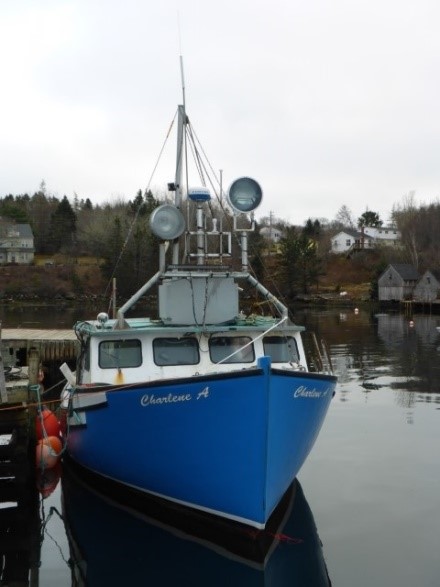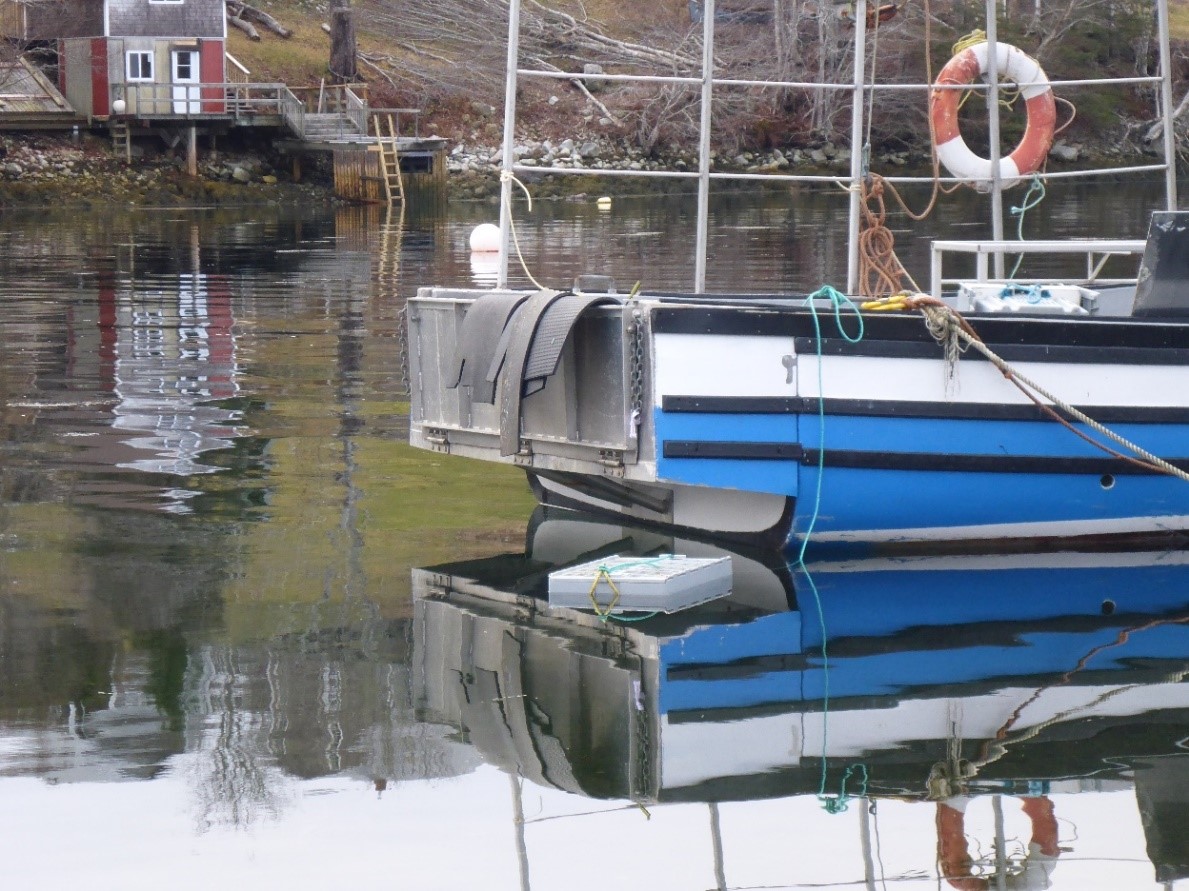Taking on water and sinking
Fishing vessel Charlene A
Boutiliers Cove, Nova Scotia
The Transportation Safety Board of Canada (TSB) investigated this occurrence for the purpose of advancing transportation safety. It is not the function of the Board to assign fault or determine civil or criminal liability. This report is not created for use in the context of legal, disciplinary or other proceedings. See Ownership and use of content.
Description of the vessel
The Charlene A (Figure 1) is a Canadian-registered (registration no. 395971), 10.15 m longliner-style fishing vessel of 13.49 gross tonnage (GT). The vessel is constructed of moulded glass-reinforced plastic and powered by a diesel engine turning a single propeller shaft. The wheelhouse is equipped with an electronic chart plotter system,Footnote 1 a radar, an echosounder, a GPS (global positioning system), and 2 very high frequency (VHF) radiotelephones. The vessel is also fitted with 2 bilge pumps, 1 automatic and 1 manual. An inflatable life raft, 4 lifejackets, and 4 survival suits were also carried on board.
The vessel had been modified in the summer of 2018, when a stern extension and hinged tailgate-style bulwarkFootnote 2 (Figure 2) was installed. The vessel was not fitted with a bilge alarm system or an emergency position-indicating radio beacon.
History of the voyage
Before 26 November 2018, in preparation for the opening of lobster fishing season, the vessel crew loaded the Charlene A’s aft deck with 150 lobster traps, 6 of which were placed on the vessel’s open tailgate. The crew also installed threaded plugs in the vessel’s scuppersFootnote 3 to prevent water ingress when the vessel was fully loaded. During the loading, the vessel’s scuppers were submerged from the weight of the traps.
At approximately 0650Footnote 4 on 01 December 2018, it was observed that there was approximately 25 cm of freeboard below the tailgate. Just after 0700, the vessel, with the master and 3 crew members on board, departed a private wharf in Boutiliers Cove, Nova Scotia, to set the lobster traps in the St. Margarets Bay area. All on board were wearing personal flotation devices (PFDs). The Charlene A transited Boutiliers Cove behind other lobster fishing vessels that were also heading out for the opening day of the season. At about 0708, a crew member checked the stern for water ingress and found none.
At about 0710, the vessel cleared the mouth of the harbour, and the master turned the rudder to port to round a buoy marking the channel. While rounding the buoy, the vessel heeledFootnote 5 to starboard. After the master cleared the buoy, he brought the vessel’s rudder to amidships to steer the vessel toward the fishing grounds. Completing the turn did not restore the vessel to the upright position as expected, and the vessel continued to list to starboard.
At approximately 0711, the master directed a crew member to check the stern. When the crew member checked the stern, the vessel was rapidly taking on water over the tailgate. As water accumulated on deck, the vessel freeboard decreased, which submerged the deck to the point where downflooding occurred through vents located under the gunwale and into the fish hold. The master turned the vessel to starboard to return to shore and, using VHF channel 6, informed nearby vessels that the Charlene A was in distress. The fishing vessel Double Maw responded and escorted the Charlene A in order to assist if needed.
At about 0712, 2 crew members started throwing lobster traps overboard to lighten the vessel’s load and increase the freeboard, but water continued to flood the deck. The master continued toward shore, guided by directions from a crew member standing on the elevated bow.
At approximately 0715, just before the vessel capsized, the crew member on the bow returned to the wheelhouse. The master turned the vessel to port so the 2 crew members throwing traps overboard could jump into the water. As the vessel listed severely to starboard, the 2 crew members who had been throwing traps jumped into the water, followed by the crew member in the wheelhouse. All 3 crew members were retrieved from the water by crew members of the Double Maw.
Moments later, the vessel capsized, trapping the master in the wheelhouse. The master’s PFD inflated. The master swam out of the wheelhouse and toward the surface of the water. Once he broke the surface, the master was retrieved by crew members of the Double Maw. The capsized vessel was towed to shore and subsequently righted.
At the time of the occurrence, the seas were calm and the wind was 3.8 knots from the north-northwest. The sea temperature was about 5 °C and the air temperature was 1 °C.
Fishing vessel regulations and Transport Canada guidance documents
In July 2017, the Fishing Vessel Safety Regulations (FVSR)Footnote 6 came into force. These regulations apply to all Canadian fishing vessels that do not exceed 24.4 m in length and do not exceed 150 GT. The regulations include requirements for the safe operation of these fishing vessels, safety equipment and maintenance, lifesaving appliances, fishing vessel stability, records of maintenance and modifications, and written operational procedures. The regulations also state that the authorized representatives and the masters of fishing vessels are responsible for ensuring that their vessels meet regulatory requirements. These regulations apply to the Charlene A.
In 2018, Transport Canada (TC) published guidance documents entitled Guidelines for Fishing Vessel Major Modifications or a Change in Activity (TP 15392)Footnote 7 and Adequate Stability and Safety Guidelines for Fishing Vessels (TP 15393).Footnote 8 These voluntary guidelines were developed jointly with the Canadian Independent Fish Harvesters Federation and with input from industry stakeholders at the Canadian Marine Advisory Council. The guidelines provide technical information and guidance to fish harvesters, and promote safe on-board practices.
The master of the Charlene A was not aware of the publication or requirements of the new regulationsand was not familiar with the above-mentioned guidance documents.
Dissemination of safety information
TC’s primary method of distributing safety information, such as amendments to regulations and the issuance of guidance documents, is through Ship Safety Bulletins (SSB). SSBs are published on TC’s website or sent directly to subscribers by email.
Before this occurrence, TC had issued SSB 01/2008Footnote 9 and SSB 03/2017,Footnote 10 both of which contain information relevant to the Charlene A’s operations. The Charlene A’s master was not subscribed to TC’s automatic SSB delivery service. The master also had not sought out SSB 01/2008 and its accompanying Fishing Vessel Modification History form,Footnote 11 or SSB 03/2017, which describes the changes to the FVSR.
In 2018, TC issued TP 15356 E, which provides guidance to support small vessel operators in participating in the Small Vessel Compliance Program.Footnote 12 This voluntary program helps operators of small commercial vessels to understand and meet the safety and environmental requirements of the Canada Shipping Act, 2001 and the FVSR. The master was not a member of the Small Vessel Compliance Program or any fish harvester association at the time of the occurrence.
Major vessel modifications
A major modification to a fishing vessel is a modification, or series of modifications and repairs, that substantially changes the capacity or size of the vessel, or substantially changes the nature of any on-board system affecting the vessel’s watertight integrity or its stability.Footnote 13 Under the FVSR, when such a modification is carried out, the authorized representative and the master must ensure that the vessel undergoes a full or simplified stability assessment, as required. If a full stability assessment is conducted, a stability booklet must be prepared for the vessel; if a simplified stability assessment is conducted, a record of stability must be issued to the vessel.
TC guidelines on fishing vessel major modifications indicate that the addition of a permanent stern ramp extension, such as the extension and hinged tailgate added to the Charlene A, will change the position of the vessel’s centre of gravity.Footnote 14
The master of the Charlene A modified the vessel’s stern in the summer of 2018 by installing a stern extension that included a hinged tailgate (Figure 2). The tailgate could be opened by lowering it, and it provided an open stern for setting traps. The extension increased the length of the vessel, and when the deck was fully loaded with traps, the vessel’s stability and trim was altered from its original condition. Having the tailgate open also reduced the protection afforded by the transom to prevent water from ingressing over the stern.
Before installing the extension and tailgate, the master did not determine if the vessel had sufficient reserves of stability that would allow it to be safely modified. After the vessel was modified, no stability assessment was conducted, nor was a record of stability prepared as required by the FVSR.Footnote 15 Similarly, a Fishing Vessel Modification History Form was not completed.
Safety messages
Under the FVSR, it is the responsibility of the master and the authorized representative of a fishing vessel to ensure that the vessel is compliant with applicable regulatory and safety requirements. If vessels are modified and stability assessments not conducted, masters, authorized representatives and crew may be unaware of adverse changes in vessel stability characteristics which may affect the safety of the vessel.
It is important for masters, authorized representatives, and crew of fishing vessels to keep themselves informed of any changes in the regulations and of the issuance of any guidance documents that apply to their vessels. Masters and other mariners can research or subscribe to Ship Safety Bulletins through TC’s website to obtain this information.
This report concludes the Transportation Safety Board of Canada’s investigation into this occurrence. The Board authorized the release of this report on . It was officially released on .

